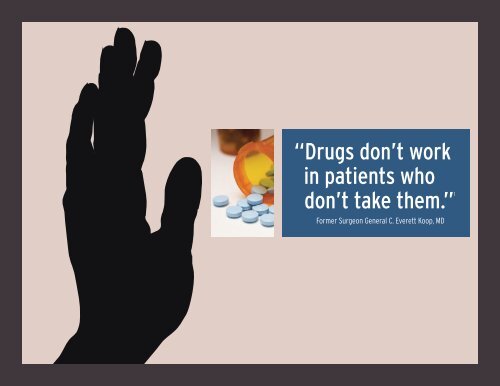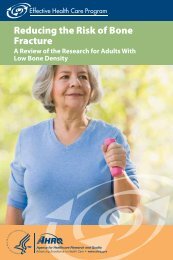“Drugs don’t work in patients who don’t take
âDrugs don't work in patients who don't take them.â1
âDrugs don't work in patients who don't take them.â1
You also want an ePaper? Increase the reach of your titles
YUMPU automatically turns print PDFs into web optimized ePapers that Google loves.
<strong>“Drugs</strong> <strong>don’t</strong> <strong>work</strong><br />
<strong>in</strong> <strong>patients</strong> <strong>who</strong><br />
<strong>don’t</strong> <strong>take</strong> them.”1<br />
Former Surgeon General C. Everett Koop, MD
Poor adherence — <strong>in</strong>creas<strong>in</strong>g the risk of serious consequences<br />
The World Health Organization reports that an<br />
average of 50% of medications are not <strong>take</strong>n as<br />
prescribed <strong>in</strong> the US. 2 This alarm<strong>in</strong>g rate of nonadherence<br />
<strong>in</strong>cludes <strong>patients</strong> tak<strong>in</strong>g drugs for serious<br />
conditions such as high blood pressure, high cholesterol,<br />
and diabetes. The consequences of poor<br />
adherence to physician-prescribed therapies are a<br />
critical issue impact<strong>in</strong>g the health and productivity<br />
of many Americans. Accord<strong>in</strong>g to primary care<br />
physicians, the health of 1 <strong>in</strong> 5 <strong>patients</strong> is compromised<br />
by nonadherence. 3<br />
Only 22% of <strong>patients</strong> are considered extremely<br />
compliant by their physicians 3<br />
Not at all<br />
compliant<br />
8%<br />
Not very<br />
compliant<br />
16%<br />
Somewhat<br />
compliant<br />
27%<br />
Extremely<br />
compliant<br />
22%<br />
Very<br />
compliant<br />
27%<br />
Based on a 2007 market research survey of physicians by Guidel<strong>in</strong>e Inc.<br />
Adapted from MedAdNews. 3<br />
Poor adherence has been identified as the primary<br />
cause of poor blood pressure control, while good<br />
adherence has been shown to reduce the development<br />
of complications <strong>in</strong> <strong>patients</strong> with diabetes, as<br />
well as to improve life expectancy. 2<br />
Nonadherence is associated with 125,000 deaths<br />
annually and 10% of all hospitalizations with an<br />
estimated cost of more than $100 billion per year. 1,3-5<br />
In addition to health care costs, the value of lost<br />
productivity, wages, and other economic losses has<br />
been estimated at $50 to $77 billion per year. 4,5<br />
Poor adherence can lead to higher medical costs,<br />
<strong>in</strong>clud<strong>in</strong>g costs for hospitalizations and ER visits 6<br />
Cost ($)<br />
Mean medical and drug costs by adherence-rate<br />
category over 12 months (<strong>patients</strong> with diabetes)<br />
18,000<br />
16,000<br />
14,000<br />
$12,976 $13,077<br />
12,000<br />
$11,484<br />
10,000 $8887<br />
8000<br />
$11,008* $11,200*<br />
6000<br />
$9363*<br />
$6377<br />
4000<br />
2000<br />
0<br />
$2510<br />
$2121<br />
$1970<br />
$1877<br />
n=1801<br />
n=599<br />
n=419<br />
n=259<br />
Most<br />
Adherent<br />
More Medium Less<br />
*P
As co-pays go up, compliance goes down 13<br />
Compliance rate (%)<br />
90<br />
80<br />
70<br />
60<br />
50<br />
0 $10 $20 $30 $40<br />
*Based on average trend data.<br />
Benefit design can promote adherence and better health outcomes<br />
For chronically ill <strong>patients</strong>, traditional cost shar<strong>in</strong>g<br />
can discourage adherence to medications 15<br />
In traditional cost shar<strong>in</strong>g, the amount that <strong>patients</strong><br />
pay has no relationship to the treatment. 15 Chronically<br />
ill <strong>patients</strong> at high risk of repeated heart attacks and<br />
hospitalizations pay the same co-paymentsashealthy<br />
<strong>patients</strong> <strong>who</strong> are at low risk.<br />
Value-based strategies seek to improve adherence<br />
and health by reduc<strong>in</strong>g f<strong>in</strong>ancial barriers to the<br />
use of medic<strong>in</strong>es by <strong>patients</strong> <strong>who</strong> are at higher risk 15<br />
Adapted from Goldman DP et al. 13 Value-based benefit strategies can improve adherence<br />
by lower<strong>in</strong>g or elim<strong>in</strong>at<strong>in</strong>g co-pays for<br />
Increases <strong>in</strong> co-pays have the greatest effect on the<br />
elderly and lower-<strong>in</strong>come <strong>patients</strong>. Poor adherence<br />
may lead to <strong>in</strong>creased risk of adverse cl<strong>in</strong>ical outcomes,<br />
particularly <strong>in</strong> more vulnerable patient<br />
Value-based<br />
populations. 14<br />
Traditional<br />
benefits<br />
$8000<br />
$7082<br />
Low-<strong>in</strong>come <strong>patients</strong> are particularly sensitive to<br />
cost shar<strong>in</strong>g<br />
$6000<br />
higher cost shar<strong>in</strong>g 14<br />
$4000 $5929<br />
Decrease <strong>in</strong> adherence associated with a<br />
$2000<br />
10% <strong>in</strong>crease <strong>in</strong> co-payments for <strong>patients</strong> with diabetes<br />
$1153<br />
0<br />
14%<br />
Basel<strong>in</strong>e<br />
Average<br />
12%<br />
sick days<br />
10%<br />
Adapted from Cranor C et al. 17<br />
Decrease <strong>in</strong> adherence (%)<br />
8%<br />
6%<br />
4%<br />
2%<br />
0%<br />
Average plan compliance* for<br />
30-day supply of cholesterol-lower<strong>in</strong>g therapy<br />
Oral antidiabetics<br />
Adapted from Chernew M et al. 14<br />
Average co-pay for 30-day supply<br />
Blood pressure medic<strong>in</strong>e<br />
Stat<strong>in</strong>s<br />
Median <strong>in</strong>come <strong>in</strong> patient ZIP code<br />
< $30K $30-42K $42-62K >$62K<br />
F<strong>in</strong>ancial<br />
barriers can<br />
discourage healthy<br />
behaviors 13<br />
Reduced<br />
f<strong>in</strong>ancial barriers<br />
promote healthy<br />
behaviors 10,15-17<br />
medic<strong>in</strong>es that have been scientifically demonstrated<br />
to prevent or delay progression of disease. 15<br />
Prelim<strong>in</strong>ary evidence supports the positive impact<br />
this approach can have on promot<strong>in</strong>g adherence to<br />
high-value medications for higher-risk <strong>patients</strong>, such<br />
as those with hypertension, diabetes, asthma, and<br />
high cholesterol. 10,16,17<br />
Evidence is also build<strong>in</strong>g that value-based benefit<br />
strategies can improve health and productivity and<br />
reduce costs. For example, the city of Asheville, North<br />
Carol<strong>in</strong>a, started provid<strong>in</strong>g free medic<strong>in</strong>es and related<br />
supplies to all <strong>patients</strong> with diabetes <strong>in</strong> 1997. While<br />
drug spend<strong>in</strong>g <strong>in</strong>creased, overall medical costs for<br />
Annual pharmacy and medical costs<br />
Case study: Asheville, North Carol<strong>in</strong>a<br />
Provid<strong>in</strong>g free drugs and supplies to <strong>patients</strong> with diabetes<br />
reduced overall medical costs<br />
$5210<br />
$3596<br />
$1614<br />
$5843<br />
$3508<br />
$2335<br />
$5882<br />
$3283<br />
$2599<br />
Rx expenses<br />
$5394<br />
$2815<br />
$2579<br />
All other medical<br />
$4651<br />
$1556<br />
$3095<br />
Year 1 Year 2 Year 3 Year 4 Year 5<br />
12.6 6.0 8.5 7.3 7.7 6.4<br />
<strong>patients</strong> with diabetes decreased after 5 years. In<br />
addition, the number of sick days among those with<br />
diabetes was reduced by 50%. 17<br />
As the burden of chronic disease grows, it’s more<br />
important than ever for governments, employers,<br />
and other health plan sponsors to consider how this<br />
approach may help improve health and restra<strong>in</strong> costs.
Key ideas that should underp<strong>in</strong> mean<strong>in</strong>gful health reform<br />
<strong>“Drugs</strong> <strong>don’t</strong> <strong>work</strong><br />
<strong>in</strong> <strong>patients</strong> <strong>who</strong><br />
<strong>don’t</strong> <strong>take</strong> them.”<br />
Former surgeon general, C. Everett Koop, MD<br />
Nonadherence is a complex and difficult issue to resolve. A comprehensive<br />
solution will require coord<strong>in</strong>ated efforts <strong>in</strong>volv<strong>in</strong>g all s<strong>take</strong>holders <strong>in</strong>clud<strong>in</strong>g<br />
<strong>patients</strong>, physicians, employers, pharmaceutical companies, and health<br />
coverage providers<br />
Effective health care reform proposals should <strong>in</strong>clude <strong>in</strong>itiatives to improve<br />
adherence<br />
High co-payments and lack of adequate prescription coverage <strong>in</strong>crease<br />
nonadherence, particularly among lower-<strong>in</strong>come <strong>patients</strong> and <strong>patients</strong> with<br />
multiple medications<br />
Proper adherence can help at-risk <strong>patients</strong> and payers avoid higher medical<br />
costs <strong>in</strong> the future by improv<strong>in</strong>g health outcomes<br />
References: 1. Osterberg L, Blaschke T. Adherence to medication. N Engl J Med. 2005;353(5):487-<br />
497. 2. World Health Organization. Adherence to long-term therapies: evidence for action. Geneva,<br />
Switzerland: World Health Organization; 2003. 3. Whitcup MS, Garcia-Lopez J. 2008 patient adherence<br />
update: new approaches for success. The Trend Report Series. Med Ad News. October 2008.<br />
4. Enhanc<strong>in</strong>g prescription medic<strong>in</strong>e adherence: a national action plan. National Council on Patient<br />
Information and Education Web site. http://www.talkaboutrx.org/documents/enhanc<strong>in</strong>g_prescription_medic<strong>in</strong>e_adherence.pdf.<br />
Accessed January 29, 2009. 5. Peterson AM, Takiya L, F<strong>in</strong>ley R. Metaanalysis<br />
of trials of <strong>in</strong>terventions to improve medication adherence. Am J Health-Syst Pharm.<br />
2003;60:657-665. 6. Sokol MC, McGuigan KA, Verbrugge RR, Epste<strong>in</strong> RS. Impact of medication adherence<br />
on hospitalization risk and healthcare cost. Med Care. 2005;43(6):521-530. 7. Prescription drug<br />
compliance a significant challenge for many <strong>patients</strong>, accord<strong>in</strong>g to new national survey. The Wall<br />
Street Journal Onl<strong>in</strong>e Web site. http://www.harris<strong>in</strong>teractive.com/news/newsletters/wsjhealthnews/WSJOnl<strong>in</strong>e_HI_Health-CarePoll2005vol4_iss06.pdf.<br />
Accessed January 29, 2009. 8. Lee JK,<br />
Grace KA, Taylor AJ. Effect of a pharmacy care program on medication adherence and persistence,<br />
blood pressure, and low-density lipoprote<strong>in</strong> cholesterol: a randomized controlled trial. JAMA.<br />
2006;296(21):2563-2571. 9. American College of Physicians. Achiev<strong>in</strong>g a high-performance health<br />
care system with universal access; what the United States can learn from other countries. Ann Intern<br />
Med. 2008;148(1):55-75. 10. Mahoney JJ. Value-based benefit design: us<strong>in</strong>g a predictive model<strong>in</strong>g<br />
approach to improve compliance. J Manag Care Pharm. 2008;14(6)(suppl S-b):S3-S8. 11. Chapman<br />
RH, Benner JS, Petrilla AA, et al. Predictors of adherence with antihypertensive and lipid-lower<strong>in</strong>g<br />
therapy. Arch Intern Med. 2005;165:1147-1152. 12. Goldman DP, Joyce GF, Escarce JJ, et al. Pharmacy<br />
benefits and the use of drugs by the chronically ill. JAMA. 2004; 291(19):2344-2350. 13. Goldman DP,<br />
Joyce GF, Karaca-Mandic P. Vary<strong>in</strong>g pharmacy benefits with cl<strong>in</strong>ical status: the case of cholesterollower<strong>in</strong>g<br />
therapy. Am J Manag Care. 2006; 12(1):21-28. 14. Chernew M, Gibson TB, Yu-Isenberg K, Sokol<br />
MC, Rosen AB, Fendrick AM. Effects of <strong>in</strong>creased patient cost shar<strong>in</strong>g on socioeconomic disparities<br />
<strong>in</strong> health care. J Gen Intern Med. 2008;23(8):1131-1136. 15. Chernew ME, Rosen AB, Fendrick AM. Valuebased<br />
<strong>in</strong>surance design. Health Aff (Millwood). 2007;26(2):W195-W203. 16. Chernew ME, Shah MR,<br />
Wegh A, et al. Impact of decreas<strong>in</strong>g copayments on medication adherence with<strong>in</strong> a disease management<br />
environment. Health Aff (Millwood). 2008;27(1):103-112. 17. Cranor CW, Bunt<strong>in</strong>g BA, Christensen<br />
DB. The Asheville project: long-term cl<strong>in</strong>ical and economic outcomes of a community pharmacy<br />
diabetes care program. J Am Pharm Assoc. 2003;43:173-184. CGC21909 © Pfizer 2009 All rights reserved. Pr<strong>in</strong>ted <strong>in</strong> USA/February 2009<br />
Health benefits should offer f<strong>in</strong>ancial <strong>in</strong>centives that encourage adherence and<br />
disease prevention and that also empower <strong>patients</strong> to <strong>take</strong> more active roles <strong>in</strong><br />
their health care<br />
Health plans should consider value-based benefit designs, which reduce f<strong>in</strong>ancial<br />
barriers to medic<strong>in</strong>es and promote adherence, better health, and wellness<br />
Physicians should have all of the educational and technological tools necessary<br />
to educate <strong>patients</strong> about the benefits, risks, and proper use of prescribed<br />
medic<strong>in</strong>es




